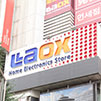After Dark: Times Still Hard
Efforts by the Liberal Democratic Party government to jump-start the economy have seen stock prices soar and the value of the Japanese yen plummet, to the glee of exporters.
Some believe that if things were really on the upswing, this would be indicated by outlays for corporate entertainment. So the Nikkei Marketing Journal (24 April) surveyed expenditures in three major urban areas famed for their nightlife: Ginza (Tokyo), Sakae (Nagoya) and Kitashinchi (Osaka).
The news, unfortunately, was not very heartening. By the time both hands on Ginza Wako’s clock point to midnight, streams of people can be seen flowing towards Ginza Station, while taxis remain lined up in a 400-metre queue.
Out of the 38 Ginza restaurants surveyed, 24% said business was “good”. Among 33 bar and nightclub owners queried, just 15% gave the same response. Meanwhile, out of 31 taxi drivers, only 3% described the times as being good.
The situation is similar in Nagoya’s Sakae district. “Before the Lehman Shock [in 2008], customers often ran up charges of ¥10,000 to go back home to the suburbs. Now it’s just a short ¥1,000 ride to Nagoya Station”, grumbled one taxi driver.
Located within Sakae, Nishiki is where staff members of Toyota Motor Corporation and their various vendors typically go to drink. It’s been said that if the automobile business catches a cold, Nishiki sneezes.
Thanks to the recent decline in the value of the yen, car sales are up, and the area’s denizens yearn for better times that, it is hoped, will come very soon.
In the good old days, popular hostesses in Osaka’s Kitashinchi neighbourhood would expect male customers to meet them for a light meal and some shopping a few hours prior to their bar opening and before accompanying them into the establishment. Now, however, the girls wait for their customers on the street outside the bar. No more meal tickets for them, alas.
Prime Minister Shinzo Abe’s policies aimed at bolstering small and medium-sized firms have led to a change in the tax code. The allowable expenditures for wining and dining have been raised to ¥8mn per year. What’s more, these outlays can now be applied even when the books show a loss.
Yuichi Kamiya, an office director at Ginza Shako Ryoin Kyokai, General Inc., an association of Ginza establishments that was founded in 1925 and currently has 1,695 member businesses, told the Nikkei: “Drinking and concluding contracts go together. We’d like to be thought of as one of the gears that turns the Japanese economy”.
Parental Presents
Mother’s Day and Father’s Day fall on 12 May and 16 June, respectively. In March, Macromill, Inc. undertook a survey in which 1,000 adults were asked about their plans to give gifts on these days.
According to the Nikkei Marketing Journal (24 April), the practice now appears to be fairly well ingrained in Japan, with 28.4% of female respondents and 17% of males saying they unfailingly give a gift every Mother’s Day. The respective figure for Father’s Day was somewhat lower: 19.2% for females, 12.2% for males.
The gifts of choice for mums were hardly surprising. The most common reply was flowers (44.2%), followed by apparel or fashion accessories (21.7%). For dads, the top choices were alcoholic beverages (30.8%) and articles of apparel or accessories (27.2%).
Just over 30% of respondents stated that their allocated budget for such purchases—for both parents—is between ¥3,000 and ¥5,000. About 90% of those questioned said they expected the outlay would be unchanged from 2012.
Will New LDP Policies Foment Clock-watching?
As the clock changes from 4:59pm to 5:00pm, a young worker stands up, pushes back his chair and, without further ado, heads straight for the lift.
“These goji-pita otoko (exactly-5-o’clock men) are on the increase”, Tomoyuki Suzuki, personnel consultant and president of Wealth Share Inc., told the Nikkan Gendai (17 April).
“Abenomics is the process of considering the transfer of human resources away from mature industries to those that promise growth”, Suzuki explained. “As a result, white-collar workers who are employed at major firms are being entrusted with implementation jobs.
“The Abe government is also inclined to increase the number of positions for semi-regular workers, such as those with short-term jobs and task-specific jobs. This is likely to result in falling morale among growing numbers of workers”, he added. Will we see goji-pita incrementally changed to yoji-pita (exactly 4pm)? Or even sanji-pita (exactly 3pm)?
“Some firms are already moving towards what is, effectively, a retirement age of 45”, he said. “As such a trend is costly, I suppose those firms are likely to increase the number of their subsidiaries, and transfer workers there from the age of 45, or even rehire them [under a different pay structure]”.
During the bubble economy, salaried workers called goji-kara otoko (after-5 o’clock men) became conspicuous for their eagerness to boogie after work. But this new variation—the goji-pita bunch—is likely to negatively impact the morale of their co-workers. For someone to bring documents to a desk at 5:01pm, only to be abruptly told, “Sorry, but that’s it for today” has been unheard of in Japan—until now.
Unless people take a stand and nip Abenomic policies in the bud, the salaryman culture that has developed here over the past 70 years may very well come crashing down, the Nikkan Gendai predicts.
Getting Them Young
The term gakuwari (student discount) has taken on a new meaning with the launch of campaigns by Japan’s three major mobile communications providers.
The Nikkei Business (22 April) reports that, starting in spring, NTT Docomo, Inc.’s plan that is aimed at juveniles will be extended to include preschoolers aged three and over. Docomo’s move came after rival Softbank Mobile Corp. announced its new White Gakuwari family plan that has no age restrictions.
In September last year, Docomo launched sales of children’s mobile phones and, from this spring, reinforced its product line-up with smartphone models aimed at juniors.
According to a survey by ICT Research & Consulting, some 11,310,000 junior- and high-school pupils, and university students in Japan use mobile phones. Although the youth demographic has been shrinking, there is still room for overall growth. In addition, the providers are hoping that sales geared to the use of mobile phones by the youngest family members might win over the parents and older siblings.
Other businesses have also been reaching out to young customers. Japan Airlines has expanded its JAL Card Navi programme for students, which waives annual membership charges and permits accrued mileage points to be retained for an indefinite period while the cardholder is still a student. The Mitsui Sumitomo Card has joined with Amazon Japan to offer its Mitsui Sumitomo Visa Debit Plus Card to younger consumers.
The article points out that credit card services have, in the past, found the youth market less lucrative because of limitations on giving them cash advances. Thus they are turning to encouraging use of their cards for shopping, with the rationale that it will nurture children as future core users.
But in the writer’s view, dropping the minimum customer age to three years may be a sign that those businesses are growing desperate as they face the prospects of shrinking demand.





